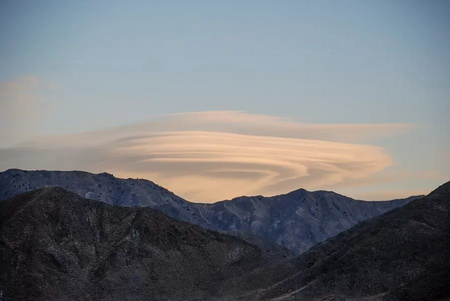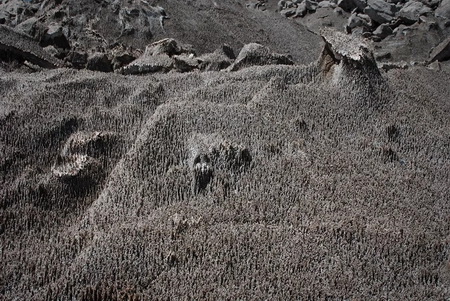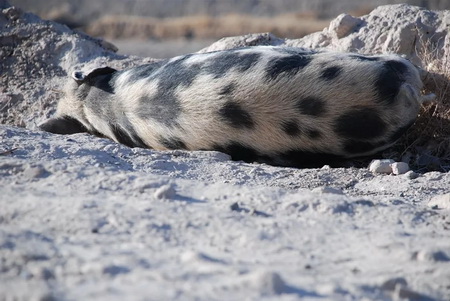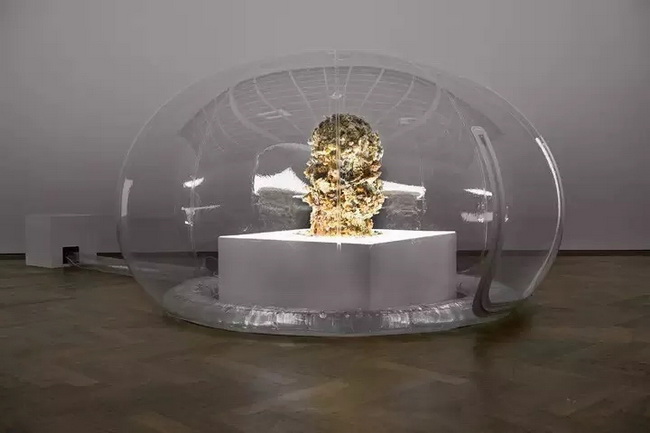
庄辉丨公元前1650年
Zhuang Hui | 1650 B.C.
策展人:常旭阳
Curator: Chang Xuyang
艺术总监:楠楠
Director: Nan Nan
展期:2019年3月15日-5月15日
Duration: 2019.3.15-5.15
地点:新世纪当代艺术基金会丨北京798艺术区797东街A05
VENUE: New Century Art Foundation丨No.A05, 797 East Rd., 798 Art Dist., Beijing

▲ 《万物—001》丨Everything 001
可移胶丝绢打印丨Print on Removable Silk
120 × 80cm
2006
庄辉:构建自我观照世界的方式
文/常旭阳
转变
庄辉三十年的艺术实践中,媒介涉及到绘画、装置和影像,而最常见的是摄影作品。但我们不能称之为摄影艺术家,因为摄影语言的技巧并不是庄辉感兴趣的,摄影回归到它最基本的功能——记录,是艺术家在大千世界中行走并行动时最直接便捷的记录工具。摄影与绘画雕塑一样,这些静态的艺术形式给予观众更多“凝视”的时刻,通过游移、打量、分辨、寻找的目光,无限可能地打开回忆与想象的一道道闸门。这也是今天我们再看庄辉二十多年前著名的《一个和三十个》和《大合影》等系列时,随着时间的流逝被一次次更深地打动的原因。
庄辉通常被视为观念艺术家,从最早的作品《为人民服务》(1993年)中为劳动人民分发毛巾、放露天电影、写宣传标语,到2000年左右的装置作品《茶山镇》、《带钢车间》和《筒子楼》,再到2008年整年的艺术计划《玉门》,通过对底层劳动者现状的调查和呈现,表达了艺术家强烈的希望通过艺术改变社会的愿望。《玉门》项目为庄辉带来了名誉,但同时也使庄辉陷入了深深的关于“艺术何为”的困惑和困境。同期对如大庆、攀枝花等此类资源枯竭型城市的走访调查,使其“对人的生存处境有了更加理性的认识,这之后对人类的行为保持着怀疑的态度”。
如果仅仅将庄辉视为观念艺术家,没有对一些隐形线索的了解,我们便容易把当下置身事外的“老庄”式云游状态,和他呈现给我们的远离社会问题的图像,理解为“虚无主义”式的逃遁,或“回归自然”的浪漫主义。

▲ 《万物—050》丨Everything 050
可移胶丝绢打印 Print on Removable Silk
120 × 80cm
2006
流浪
其中一条隐形线索便是,我更愿意将庄辉看作一位“艺术劳动者”和“艺术流浪者”,庄辉之所以在中国当代艺术中特殊、重要且难以归类的原因也在此。艺术家的身世和经历本不该成为传奇,但庄辉的身世和经历之所以重要是因为这种影响时至今日都显而易见。庄辉童年时父母早逝,而后从16岁开始在洛阳拖拉机厂当了19年工人,一直到1997年。这种经历使其对劳动人民充满“同理心”,在《一个和三十个》和《大合影》中,艺术家露出洁白的牙齿憨笑地站在劳动者身边,无论是个体还是群体被“艺术”记录下来呈现出人性的光,而“在一起”的情感纽带对庄辉来说是内在的需求。
说庄辉是一位“艺术劳动者”不仅因其长期以来关注和表现这个群体,而且过劳动人民的生活也是庄辉的需要。二十年前庄辉就说过“我旅行的时候喜欢走路,和当地人一样挤长途汽车,到两块钱一晚的土坑上去住”,今天即便生活在物质充裕的城市,庄辉仍然有这种出于生理和情感上的需要。在拍摄《万物》系列的十几年中,为什么一次次地远离城市,走向如此“荒芜”的西北高原,我想那里的人和生活方式在无形中吸引着他,只是不在《万物》的图像中充当主体。而“流浪”是庄辉想事和解决问题的方式。“从小没有父母的指引,在遇到问题想不通的时候我就会搭上一列火车去向远方,发现换一个空间原来的问题可能就不是问题了。”

▲ 《万物—055》丨Everything 055
可移胶丝绢打印 Print on Removable Silk
120 × 80cm
2006
艺术的价值
另一条线索是《玉门》之后庄辉对艺术的重新认识。
艺术在历史上曾经是工具(宗教的、亦或延安文艺座谈会制定的方针)、是流派、是主义(现代艺术)等等,但在今天当代艺术再也不充当某类群体的宣言,再也不必须代表某种进步。历史上伟大的艺术家之所以伟大正因为在潮流到来之前贡献了他的个体视角,而当代艺术的意义和魅力甚至只能是个体价值的显现。今日的社会和生活在制度、资本、科技等力量的漩涡式裹挟下,越来越被流程化、编码化和模式化,这些制度、资本和技术带来的是一种更无形的控制。如何避免文明越来越趋于同质化,如何保存一些例外状态,在自留地或野地中生长野花杂草,而不都是集体耕种,当代艺术中艺术家个体的思维方式和探索方式逾差异化,就逾有益于这个目标,甚至是一种更好的批判的方式。
在《玉门》计划之后,庄辉开始反思他以艺术改造社会的实践之路的有效性。鲁迅弃医从文,是因为认识到医术只能拯救人的肉体,而文艺将影响人更本质的精神。庄辉放弃社会介入式的艺术项目,正是发现其对社会的改变只在皮毛表层甚至只如过眼云烟,他逐渐认识内在的、基于个体思维能力和探索方式而形成的世界观和方法论,“构建自我的关照世界的方式”,才是艺术有可能提供给世界和他人的价值。于是作为“艺术流浪者”和“劳动者”的庄辉开始了他艺术探索的新阶段。相较于之前在北京常青画廊举办的“祁连山系”一展,此次以摄影系列《万物》为主体构建的展览“公元前1650年”,减少了艺术家对图像的干预,正如他假想的未受人类干预的自然,以质朴的方式将我们带入另一个空间和时间。

▲ 《万物—045》丨Everything 045
可移胶丝绢打印 Print on Removable Silk
120 × 80cm
2006
另空间
虽然城市是庄辉维持一定社会关系和塑造身份的场所,但这里并没有太多吸引他的事物。充斥城市的多为人造物和消费品,在城市中生活,人的关注点往往是自我——自我的欲望及如何满足这些欲望,欲望导致人们之间对于资源和权力的争夺。减少欲望和降低物质性的需求是思考形而上问题的前提。思想者可以足不出户思索宇宙的奥秘,而对于庄辉来说,身体力行——长时间暴露在各种不可预测的自然环境中的行走、对真实事物的触摸和观察、全身心打开自我的感知系统——是接近形而上生活的方式。人类是想象和观念的动物,文明的发展是越来越长时间地呆在洞里(室内)的过程,越来越沉浸在人造观念和虚拟世界中,而对于庄辉个人来说,他需要走向野外,走向真实。这种流浪或游荡更接近于《庄子》中“鲲化为鹏,鹏飞南溟”的逍遥游。这些游荡旅程中和自然有关的部分片段构成了《万物》系列。
《万物》中的自然多数不是“只缘身在此山中”的停僮葱翠的南方景致,而主要是以祁连山为主的旷远峭拔的西北高原地貌。一千多公里长、拥有戈壁、沙漠、草原、雪山等不同地貌的祁连山是艺术家庄辉的“工作室”。天开地阔的空间带给人们崇高神性的宗教体验;当我们用心观察自然的细节,不免感叹人造物在很多层面无法达到这样的精妙。庄辉想做的正是通过他行走中随手的采撷,将我们带去另一个空间,在那里,人、动物、植物、石头、河流都仿佛是洪荒世界时造物主留下的讯息,彼此平等且相通;而在那个空间提示出的时间维度中,人类文明只是小荷尖角。在庄辉看来,如果所有人的生活、目光和意识都围绕在人自身所做的事情上,缺少另一个空间和另一种运行模式的参照系统的话,无限膨胀的人类有着可怕的力量。

▲ 《万物—016》丨Everything 016
可移胶丝绢打印 Print on Removable Silk
120 × 80cm
2006
具体的事物 美的事物
今天我们对世界的认知更多建立在以“数理科学”为基础的知识体系之上,是一种可归纳、可分析、可建立模型的思维方式。但这样的“世界观”在促进科技迅猛发展的同时,也导致了人与自然的紧张关系及人对自然的狭隘认识。在这个意义上庄辉的摄影更偏向“博物学”,即“搜集自然的物品”。他将镜头甚至聚焦到山石的龟裂纹理或一片刚燃烧过的秸秆地,将话语权更多地赋予了这些具体的事物,让事物的具体来感染我们,这些具体的“表情”如此丰富迷人。
旱地中的一汪泉水
青稞地和沙地上的风洞让我们感受到看不见的力量
瞬间冻住的浪花
阳具山
路边死去的狗、猪、羊
似大笔触颜料或皴法画出的山
一朵胖乎乎的云
一个坐在树上的男人
大约3800年前死去的美丽的女人

▲ 《万物—049》丨Everything 049
可移胶丝绢打印 Print on Removable Silk
120 × 80cm
2006
《万物》系列中出现在镜头前的景和物,是一些提示和出发点,观众根据自己的经验和想象,去“重走”这些有温度、有风雨、有各种感官体验、消耗体力意志同时体会神性的空间之旅。
作品图片版权归艺术家庄辉所有
关于艺术家
庄辉
于1963年生于甘肃省玉门。他在十三岁时离开家乡,并开始在洛阳自学绘画。1979年高中毕业后,他进入洛阳第一拖拉机制造厂成为了一名工人。1996年移居北京,成为一名自由职业身份的艺术家。
他曾经参加了不同美术馆以及艺术机构的展览,其中包括:
荷兰Foam摄影美术馆(2015,阿姆斯特丹);德国弗柯望博物馆(2014,波恩);上海当代艺术博物馆(2012,上海);盐湖艺术中心(2009,犹他州);格罗宁根博物馆(2008,格罗宁根);利物浦泰特美术馆(2007,利物浦);常青画廊(2006,圣吉米那诺);伯尔尼美术馆(2005,伯尔尼);纽约国际摄影中心(2004,纽约);蓬皮杜艺术中心(2003,巴黎); Deichtorhallen(2002,汉堡);巴塞尔Beyeler艺术博物馆(2001,巴塞尔);第五届里昂双年展(2000,里昂);利沃尔顿美术馆(2000,荷兰); 第48届威尼斯双年展(1999,威尼斯);第一届福冈亚洲美术三年展(1999,福冈);LCA当代艺术研究中心(1999,伦敦);艾思林根博物馆(1998,德国);NBK 艺术中心(1997,柏林); 汉堡美术馆(1996,汉堡)。
Zhuang Hui: Engender My Own Way of Concern For the World
Text/Chang Xuyang
Transition
Over Zhuang Hui’s three decades of artistic practice, his mediums span from painting to installation, video art, and the most recognized, photography. However, we cannot refer to him as a photographer, because the techniques that articulate the photographic language is not what interest Zhuang Hui. Instead, he has adopted photography for its most essential function – documentation. As the artist traversed and intervened in this world at large, photography became the most direct and convenient mean of documentation. Similar to painting and installation, the stillness of this art form provides its viewer the moments to "gaze", and search for the sight through movements, gauges, and distinctions, so the barriers between memories and imaginations would be lifted ad infinitum. This is also the reason for our profound sentimentality time and time again when we look at Zhuang Hui’s One and Thirty and Group Portrait Photo Souvenir twenty years since they were first unveiled.
Zhuang Hui is often considered as a conceptual artist. From his earliest work Serve the People (1993) where the artist distributed towels, screened outdoor films, and wrote propaganda slogans, to the installation works Chashan County, Strip Steel Workshop and Tube-shaped Apartment around year 2000, and the Yumen Project completed in 2008, his art creations, through surveys and representations of labor conditions working on the lowest social tiers, conveyed the artist’s pressing desire to transform society through artistic practice.Yumen Project earned honor and accolade for Zhuang Hui, at the same time, withdrew him to a profound confusion about “What can art do?” Around the same period, his field trips to cities such as Daqing and Pan Zhihua, the former oil reserves turned into ruins due to the depletion of natural resources, provided him with “more reasonable understanding on the conditions of people’s existence. With which, he began to hold the skeptical attitude towards human behaviors.”
If we were only to consider Zhuang Hui as a conceptual artist without learning about the underlying clues, we would easily conceive these worldly travels and these images depicting removed social issues he addresses as his nihilistic escapes or a romanticism of “returning to nature”.
Wandering
One of these implicit clues is to consider Zhuang Hui as an "art labor" and "art wanderer", as well as a reason for the uniqueness, importance and unclassifiable position Zhuang Hui holds in the field of Contemporary Chinese art. It is often unnecessary to romanticize an artist’s personal history and experiences, yet the importance still seems apparent now. Zhuang Hui’s parents passed away in his childhood, and from age 16, he became a worker at the Luoyang Tractor Factory for the next 19 years, until 1997. This kind of life experiences made him empathetic to people of the working class, who was more than comfortable to stand next to the workers and exposed his ivory teeth in One and Thirty and Group Portrait Photograph Souvenir. Either the individual or the collective documented in these “artistic” project has exuded a radiance of humanity, and the emotional ties of being “together” was what Zhuang Hui sought out internally.
To call Zhuang Hui an "art labor" is not only because of his lasting concern and representations of this class of people, but leading the life of a worker is a necessity for him. Two decades ago, Zhuang Hui said, "When I travel, I prefer to walk, and take long-distance buses like the locals, and sleep over on mud-built beds that cost two kuai per night”. Although living in the cities where material goods have become abundant, this way of life remains a necessity for Zhuang Hui, both for physical and emotional reasons. Over the decade he photographed the Everything series, the reason for him to leave the cities and march towards the “barren” plateaus in the Northwest, I think is perhaps because of the people and their lives there have always been appealing to him in discrete ways, in spite of not having assumed the protagonist role in the images of Everything. "Wandering" is the way Zhuang Hui reflects and solves issues. "Without any parental guidance in my childhood, when I encountered problems that I couldn't resolve, I'd get on a train to a land far away. Once I get there, I’d realize that I have come to a different place where former problems are no longer problems."
The value of art
The other clue is Zhuang Hui's reconsideration about art since the Yumen Project.
Historically, art has been a tool (religious, or serving utilitarian purposes such as the policies stipulated on the Talks on Art and Literature at Yan’an), a school of thought, an ism (modern art) and etc., however contemporary art today would not suffice to fulfill the manifesto of any community, neither would it be able to represent any kind of progress. The great artists in the history of humanity merited their greatness by offering their individual perspectives, while the meaning and appeal of contemporary art could only embody the values of the individual. Life and society today spiral down with the introduction of policies, capital and technology, and have become increasingly procedural, codified and stereotyped, as these policies, capitals, and technologies have brought about greater control. How should we avoid the tendency of cultural homogeny and preserve certain exceptional status, so the flowers and grass would grow freely in the wilderness, rather than planted collectively in a greenhouse. The greater differences in mode of thinking and exploration among contemporary artists are, the greater possibility there will be to achieve this goal, or even in becoming a better approach to criticism.
After the Yumen Project, Zhuang Hui began to reflect on the effectiveness of practices that adopt art for social transformation. Lu Xun abandoned medicine to engage in literature with the realization that medicine would only cure people’s flesh, while art and literature would make an impact on people’s spirit and soul. Likewise, Zhuang Hui gave up on his previous artistic practice of social intervention precisely because he had realized that his impact on society was artificial, and even, temporary. He gradually came to the conclusion that the worldviews and methodologies that are internalized, shaped through one’s ability of deliberation and modes of exploration, “that which engendered my own way of concern for the world”, should be the values art offers to the world. Hence, Zhuang Hui, the “art wanderer” and “art labor” embarked on a new phase of his artistic exploration. In comparison to his solo exhibition Qilian Range held at the Galleria Continua in Beijing, this exhibition 1650 B.C. centers on the photography series Everything, by focusing on the artist's pictorial intervention, in the same vein as the unchartered territory in nature, it emanates us into another time and space through these humble means.
Another Space
Although the city is where Zhuang Hui maintains his social relationships and builds his identity, it does not possess what appeals to him the most. As much as the cities are filled with artificial objects and consumer goods, the people who inhabit these urban environments are often only concerned about themselves – about one’s own desires and how to satisfy them, which could lead to rivalries among people for resources and power. Hence, refraining one’s desires and wants for material goods become the pretext for contemplating on metaphysical issues. Intellectuals could explore the wonders of the universe without leaving one’s home, but for Zhuang Hui, who practices what he preaches – walking over time in the unpredictable natural environment, where he touches and observes objects in reality, and opens up his system of perception whole-heartedly – are the ways of approaching the metaphysical life. Humans are beings with imagination and ideas, the development of civilization is a lasting process of being in the cave (or indoors), immersed in artificial notions and the virtual world, but for Zhuang Hui, he needs to walk into the wilderness, towards reality. This kind of wandering or itinerant practice is similar to the “Kun turns into Peng, and flies to the Southern Darkness” described in the chapter, “Free and Easy Wandering” of Zhuangzi. During the course of his journey, what were relevant to nature have been given form in the Everything series.
The nature portrayed in Everything is not the luxuriant lush Southern sceneries of “simply being there”, but the boundless and spectacular Northwestern typography around the Qianlian Mountains. Stretched out over a thousand kilometers, Qianlian Mountain, encompassing topographical phenomena such as the Gobi, desert, grassland, and snow-mountain, has become the artist's "studio". This vast space provides people with the ultimate religious experience; when we observe closely at the details found in nature, we lament the inadequacy of artificial objects that fails to attain this level of wonder. What Zhuang Hui hopes to do is to take us into a different space through the images he captures along the way, where people, animals, plants, stones, and rivers are all the messages left by the Creator in this chaotic world, who are equal and connected; being in the temporal framework of this space, human civilization is only the tip of the iceberg. In Zhuang Hui's view, if everyone's life, attention and awareness orbit around the things people do, where an alternative space or mode of operation lacks as a referential vantage point, then the conflating humanity would possess daunting power.
Particular objects, beautiful objects
Our perception of the world today is largely built on the essential knowledge system of “math and sciences”, which is the classifiable, analyzable, and archetypal mode of thinking. However, while this “worldview” pushes forward the accelerated development in technology, it also creates a tenuous relationship between man and nature and people's narrow understanding of the natural world. In this sense, Zhuang Hui's photographs capture a “natural history”, where he “collects the objects from nature”. His lens has even focused on the cracked vain of the stone, or the plot of land where straw has been burned. In doing so, he’s returned the power of discourse to these specific objects, and allowed their specificity to move us. How could these concrete “expressions” be this diverse and mesmerizing!
Spring water spurs on dry land
The wind tunnels on green land and desert make us sense an invisible power
Waves freeze over in a flash
Phallic mountains
The dogs, pigs, sheep died on the side of the road
Mountains look like they are painted in broad strokes or texturing method
A voluptuous cloud
A man sits on the tree
And the beautiful woman who have died approximately 3800 years ago
The scenes and objects appeared before the lens in the Everything series are suggestions and points of departure, with which the viewer could “re-embark” on these temperamental adventures, to weather the elements with various sensibilities according to one's own lived experiences and imaginations. While one exhausts one's physical and mental energies, one will enjoy this sacred journey through time and space.
About Artist
ZHUANG HUI
Zhuang Hui was born in 1963 in Yumen Town, Gansu Province, China. He left his hometown to study in Luoyang City at the age of thirteen and started to study painting by himself. In 1979, after graduating from high school, he became a worker at the state-run Luoyang No.1 Tractor Factory. In 1996, he moved to Beijing and became an artist. During his engaged and fruitful artistic career, Zhuang Hui participated in a number of exhibitions including Foam Photography Museum, Amsterdam (2015); Folkwang Museum, Bonn (2014); 9th Shanghai Biennale, Power Station of Art, Shanghai (2012); Salt Lake Art Center, Salt Lake City (2009); The Groninger Museum, Gron- ingen (2008); Tate Modern, Liverpool (2007); Galleria Continua, San Gimignano (2006); Haus der Kulturen der Welt, Berlin (2005); Kunstmuseum Bern, Bern (2005); Musée d’art contemporain de Lyon, Lyon (2004); Centre Pompidou, Paris (2003); Deichtorhallen Hamburg, Hamburg (2002); Beyeler Art Museum, Basel (2001); Biennale de Lyon, Lyon, FR (2000); The 1st Fukuoka Art Triennale, Fukuoka Asian Art Triennale, Fukuoka, JP (1999); LCA Contemporary Art Research Center, London (1999); Ghent Art Center, Ghent (1999). He also participated in the 48th International Art Exhibition Venice Biennale, Venice (1999); Visual Art Festival, Kunstverein and Kunsthaus, Hamburg, De(1996).
关于新世纪当代艺术基金会
新世纪当代艺术基金会(NCAF)是由收藏家王兵先生和薛冰先生共同发起的非营利基金会,旨在研究、推动中国当代艺术的发展,它将通过严肃地观察艺术、研究艺术,在现有的艺术生态系统之中为中国当代艺术的发展做一些支持补充性工作,为推广中国当代艺术提供更多更好的平台。
官方网站:http://www.ncartfoundation.org
微博:新世纪当代艺术基金会
Instagram:ncaf_china
北京空间丨朝阳区798艺术区797东街A05号 新世纪当代艺术基金会
上海空间丨徐汇区龙腾大道2555-4号 池社
【声明】以上内容只代表原作者个人观点,不代表artda.cn艺术档案网的立场和价值判断。

